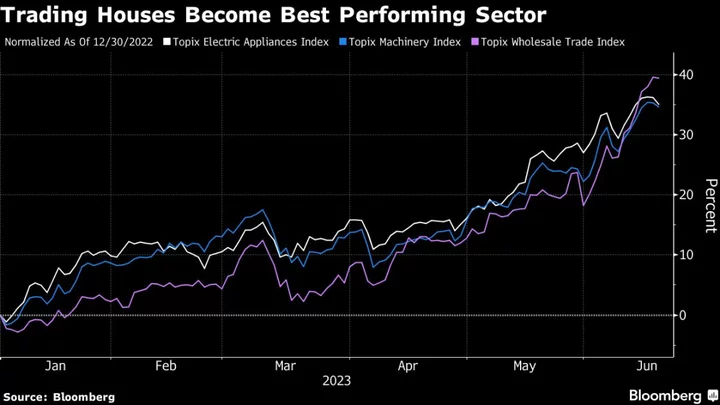This week kicks off the second-quarter earnings season, when firms in the US report on how much money they made (or didn't make) from April through June of 2023. It also brings a slew of new inflation data.
A growing group of economists say that those two things are very closely linked.
Welcome to the age of the price-price spiral, where companies hike their prices beyond the increase in their costs to boost profits.
What's happening: Inflation is coming down, finally. Prices of oil, food and materials used in production are falling after years of increases due to pandemic-era shutdowns, supply chain clogs and geopolitical turmoil.
But that doesn't mean that the prices of consumer goods are falling. In fact, in many cases, they're still going up quite quickly.
Federal Reserve Chair Jerome Powell has often warned that wage growth has to slow down for prices to ease. If employment doesn't come down, he says, inflation won't return to 2%.
But a number of Fed economists are pointing to another culprit: corporate profits.
A recent report from the Kansas City Fed found that nearly 60% of US inflation in 2021 (the year prices really began to surge) was because of an increase in corporate profits. In previous years, corporate profits contributed to about a third of price growth.
It's not just in the US, either. The International Monetary Fund has projected that corporate profits now account for nearly half of all euro area inflation.
Christine Lagarde, president of the European Central Bank, made note of the problem in a recent speech.
The "nature of the inflation challenge in the euro area is changing," she said, pointing out pandemic shocks are largely past and companies are now raising prices for different reasons.
Société Générale's global strategy economist, Albert Edwards, wrote in a note earlier this year that "the primary driver" of high inflation is companies taking advantage of customers by charging more to make an extra profit.
Customers expect price rises because they read about inflation in the press, wrote Edwards, but companies have "clearly taken advantage of rising inflation expectations" and have increased their prices even as their costs have remained the same, adding to their bottom line.
Edwards says that instead of "calling this out as the primary cause of high inflation, central banks have instead chosen to focus on rising nominal wages as threatening to embed higher inflation -- the so-called 'wage-price spiral.'"
Simply put, it's not the wage-price spiral we need to worry about, it's the price-price spiral.
In a January speech, Lael Brainard, former Fed vice chair and current director of the National Economic Council, expressed worry that a price-price spiral could ultimately tank the economy by turning consumers off from spending.
Coming up: Two major measures of inflation in the United States are out this week -- the Consumer Price Index on Wednesday and Producer Price Index on Thursday. On Friday morning, earnings reports for the second quarter kick off with JPMorgan Chase, Wells Fargo, Citi and Blackrock all reporting.
Big changes for big banks
Michael Barr, the Federal Reserve's vice chair for supervision, said on Monday that he wants to drastically alter the way we regulate big banks in the US to make them more resilient during challenging times.
A big part of that change would be an increase in the amount of money banks are required to have on hand in order to survive those tumultuous patches.
Under Barr's proposal, banks with at least $100 billion in assets would be subject to similar regulation that banks with $700 billion in assets currently face. These regulations would force banks to hold an additional two percentage points of capital, or an additional $2 of capital for every $100 of risk-weighted assets, Barr said.
"The beauty of capital is that it doesn't care about the source of the loss," Barr said in a speech on Monday where he previewed the changes. "Whatever the vulnerability or the shock, capital is able to help absorb the resulting loss."
Further details on new banking regulations are expected to be formally unveiled later this summer, reports my colleague Elisabeth Buchwald. It could take years before any changes go into effect, since they would have to go through the standard notice-and-comment rulemaking process, as with any new banking regulation.
Wells Fargo promotes Dawson Her Many Horses to managing director
Wells Fargo announced Monday that Dawson Her Many Horses, head of Native American banking for the firm, would become a managing director.
Her Many Horses, a member of the Rosebud Sioux Tribe of South Dakota, is one of the first enrolled tribal members to be promoted to managing director at a major US bank, according to a statement from Wells Fargo.
"Dawson has grown in his career from serving the financial needs of tribal governments and tribally owned enterprises to becoming the go-to national leader helping increase the flow of capital to tribal communities," said Ruth Jacks, head of diverse segments for Wells Fargo Commercial Banking.
Her Many Horses joined Wells Fargo in 2018 as senior vice president in middle market banking to focus on rebuilding the bank's Native American banking effort. In 2021, he was promoted to head of Native American Banking for commercial banking.
Wells Fargo Native American Banking is the leading provider of capital and financial services to the Native American and Alaska Native markets, according to a statement from the company. Wells Fargo has banking relationships with one out of three federally recognized tribes in the US with approximately $3.4 billion in credit commitments and $4.1 billion in deposits.









